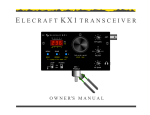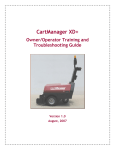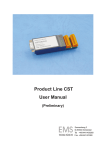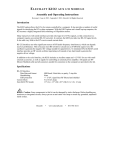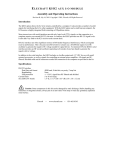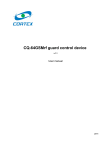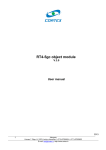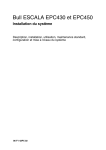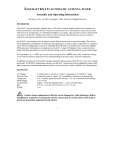Download ELECRAFT KXAT1 Operating instructions
Transcript
ELECRAFT KXB3080 30 and 80 METER ADAPTER Assembly and Operating Instructions Revision A, March 2006 Copyright © 2006, Elecraft; All Rights Reserved Introduction The KXB3080 adds 30 and 80-meter capability to the Elecraft KX1 transceiver. It also improves the receiver sensitivity on the other bands. High-performance PIN-diode switches are used to minimize insertion loss and ensure good sensitivity. The KXB3080 consists of two printed-circuit boards (PCBs). The main PCB sits between the main KX1 PCB and the front panel, directly below the encoder shaft. It is held securely in place by the leads attaching it to the main PCB. If your KX1 is currently equipped with the KXB30 adapter, the KXB3080 will replace it. A smaller PCB contains two toroidal inductors and a relay that replaces existing toroidal inductors L1 and L2 in the KX1. Because it must be extremely compact to fit in the space available, the main PCB uses a number of surface mounted devices (SMDs). All of the SMDs are pre-installed for easy assembly. Specifications 30-m coverage 80-m coverage Added current drain Size Transmit/receive: 10100-10150 kHz; receive only: 8000-12500 kHz. Transmit/receive: 3500-4000 kHz; receive only: 1000 – 5500 kHz Approx. 3 mA except approx. 18 mA on 80 meters. KXB3080 main PCB: 1-9/16” x 1-1/32” (40 mm x 26 mm) LPF1 PCB: 13/16” x 13/32” (20 mm x 10 mm) Tools Required • • • • • • • • Desoldering tool: An effective desoldering tool is essential. You will need to remove or replace several parts on the KX1 PCB. A good vacuum desoldering tool such as the Soldapullt® model DS017LS is strongly recommended to avoid damaging the PCB. Fine-tip temperature-controlled ESD-safe soldering station with 700 to 800°F tip (370-430°C). Recommend a spade tip approx. 0.05” (0.13 mm) wide. Do not use a high-wattage iron or soldering gun since this can damage pads, traces, or the parts themselves. Solder: IC-grade, small-diameter (.031”) (Kester #44 or equivalent) is recommended. DO NOT use acid-core solder, water-soluble flux solder, additional flux or solvents of any kind. Use of any of these will void your warranty. Screwdrivers: A small #2 Phillips, a small flat-blade for slotted screws and a very small flatblade (about 0.1” or 2.5 mm wide) with an insulated handle to adjust the trimmer caps. Needle-nose pliers. Small-point diagonal cutters. Flush-cutting type is required (Xcelite MS54-5J or equivalent). Hobby knife or similar tool to cut a PCB trace. 50-ohm dummy load capable of handling 5 watts, minimum. Elecraft • www.elecraft.com • 831-662-8345 • • Digital Multimeter (DMM) for voltage checks and confirming resistor values. A DMM with capacitance measurement capability is desirable, but not required. Magnifying glass or visor. Preventing Electrostatic Discharge Damage The KXB8030 main PCB is sensitive to electrostatic discharge (ESD) damage. Also, the individual PCBs in your KX1 may be vulnerable when they are unplugged. • Keep parts in their ESD-safe packaging until called for in the assembly instructions. Do not place individual PCBs in Styrofoam™ or similar containers. If possible, place loose PCBs inside ESDsafe bags when you are not working on them. • Wear a conductive wrist strap with a series 1 megohm resistor. If you do not have a wrist strap, touch a ground briefly before touching any sensitive parts to discharge your body. Do this frequently while you are working. You can collect a destructive static charge on your body just sitting at the work bench. DO NOT attach a ground directly to yourself as this poses a serious shock hazard. • Make sure your soldering iron is ESD-safe and has a grounded tip • Use a grounded antistatic mat on your work bench. Parts Inventory The table below lists the leaded parts to be installed, the pc boards, toroid cores, wire and miscellaneous hardware required. The KX1 Owner's manual has photographs of similar parts. Ref. C1, C4 C1 (see Note 1) C26 C1 (see Note 1) C9 K1 L6 L1, L2, T1 MISC (See Note 2) MISC (see Note 2) MISC MISC MISC MISC MISC MISC Description Capacitor, 1-40 pF trimmer Capacitor, 0.1 µF (104), 0.1” lead spacing Capacitor, 56 pF, (56) disc ceramic Capacitor, 15 pF, (150) disc ceramic Capacitor, Electrolytic, 10 µF, 35V (10) Relay, DPDT (G6K-2P) RF choke, 6.8 µH (blu-gry-gld) Toroidal core, T37-2 KXB3080 PCB with SMD devices pre-mounted. i Caution: ESD sensitive! See page 2. LPF1 PCB Kynar® wire, white, #24 solid Solid, insulated hookup wire, green, #24 Toroid wire, green #26 Toroid wire, red, #26 Toroid wire, red, #28 Rubber bumper, .04" thick x 0.3" square Qty 2 1 1 1 1 1 1 3 Part No. E540002 E530020 E530146 E530140 E530045 E640029 E690044 E680006 1 E120000 1 1 ft. 6” 2 ft. 4 ft. 4 ft. 2 E120001 E760032 E760008 E760004 E760002 E760003 E980017 Note 1 : Duplicate reference designators are for parts on different PCBs. The parts are clearly identified in the text. Note 2: The PCBs may have rough places along the edges. This is a normal result of the manufacturing process and will not interfere with installation. 2 For reference, the table below lists the pre-mounted surface-mounted devices. Ref. C3, C6, C7, C8, C10 C9 C2, C5 D1, D2 D3 L1, L2, L3, L4, L5 Q1 R1, R2, R6, R7 R3, R4, R5 R8 Description Capacitor, 0.1 µF Capacitor, 10 uF,10V, 20% Capacitor, 300 pF 5% NPO PIN diode, dual, common cathode Small Signal Diode RF choke, 47 µH Transistor, PNP, 2N3906 Resistor, 470 ohms 1/10 W, 5% Resistor, 240 ohms, 1/10 W, 5% Resistor, 15 k-ohm, 1/10W, 5% Qty 5 1 2 2 1 5 1 4 3 1 Part No. E530222 E530223 E530221 E560026 E560027 E690063 E580030 E500187 E500188 E500189 Assembly and Installation There are four major steps in the procedure. Follow them carefully and in the order given. 1. Modify the KXB1 PCB to install a new receiver input circuit. 2. Assemble and install the KXB3080 option PCB. Install new firmware if needed. 3. Assemble and install Low-Pass Filter LPF1. 4. Reassemble, test and align the KX1 with the KXB3080 module. Part I: Modify the KX1 PCB Disassemble your KX1 and remove the main PCB from the enclosure. If you have the KXAT1 antenna tuner option, remove it and place it in a safe place where it will be free from ESD damage. Use an ESD-safe bag if you have one available. i Very important: 1. Be careful to avoid accidentally touching components with your soldering iron. Relays and potentiometer shafts are especially vulnerable to heat damage. 2. Clear pads of all solder before attempting to install new parts. 3. As you install new components, clip all leads flush with the PCB on the reverse side. Bend C15 (near the crystals on the KX1 board) up to gain access to solder pad G under it. If present, remove the KXB30 module. Remove the KXB30 wires from the KX1 main PCB and clear the pads on the KX1 main PCB of all solder. 3 Replace C26 on the KX1 PCB (see Figure 1) as follows: Remove the existing 120 pF (121) capacitor. It will no longer be used. Clear all the solder from the pad holes. Install the 56 pF (56) capacitor supplied with the KXB3080 kit. Form the leads of the new capacitor as needed to fit. Be sure the capacitor stands no higher than 5/16” (7.9 mm) above the board. After soldering, trim the leads flush. Save the leads for use as jumpers later. Replace C1 on the KX1 PCB (see Figure 1) as follows: Remove the existing 4.7 pF (4.7) capacitor. It will no longer be used. Clear all the solder from the pad holes. Install the 15 pF (150) capacitor supplied. Form the leads of the new capacitor as needed to fit. Be sure the capacitor stands no higher than 5/16” (7.9 mm) above the board. After soldering, trim the leads flush. C26 C27 C1 L6 (Partially hidden behind pot) L7 Figure 1. KX1 PCB Original Component Locations. Remove molded inductor L7, 4.7 µH (yel-vio-gold) (see Figure 1). It will no longer be used. Clear all the solder from the pad holes. Remove capacitor C27, 150 pf (151) (see Figure 1). It will no longer be used. Clear all the solder from the pad holes. 4 Turn the KX1 PCB over and cut the trace from CB to C27/R1 as shown in Figure 2. Use a sharp hobby knife and cut across the trace several times as needed to cut through the metal. Jumper from Trace to Grounded Pad of Trimmer Capacitor CC Cut Circuit Trace Here Figure 2. Modifying Trace From Capacitor CB. Use your DMM to confirm that the cut trace is an open circuit. Check the resistance between a solder pad on one part of the cut trace and a solder pad on the other part. It should be greater than 1 megohm. Scrape off the green coating and tin a short length of the trace adjacent to the pad for trimmer capacitor CC. Use a cut lead to form a short jumper between the trace and the grounded end of CC as shown in Figure 2. Remove molded inductor L6 from the top side of the PCB (see Figure 1) and reinstall it on the bottom of the PCB as shown in Figure 3. Be sure you place the leads in the same solder pads L6 originally occupied. In case you damage the inductor while removing it, a replacement is provided: 6.8 µH (blu-grygld). When soldering L6 in place, do not fill the pad for connection A. This pad will be needed later to attach the KXB3080 module. Trim L6’s leads flush with the top of the PCB. Keep Pad "A" Clear. L6 Figure 3. L6 Relocated on Bottom of KX1 PCB. 5 Rotate potentiometer R1 fully clockwise and check the resistance between ground and the part of the cut trace that goes to the open solder pad for C27 and the center terminal of potentiometer R1. The resistance must be greater than 800 ohms. If the resistance is low, check for a solder bridge between the pad for capacitor CC and solder pad A or the adjacent pad for L6. Cut a 20” (51 cm) length of the #28 red toroid wire. (The #28 is the smaller red wire.) “Sew” the long end of the wire through the hole in one of the T37-2 toroid cores (red) for a total of 33 turns exactly as shown in Figure 4. Be sure you wind the turns the direction shown in the figure. Count one turn for each time the wire passes through the center of the core. There are no half or quarter turns when winding a toroid. The turns should fill about 90% of the toroid core as shown in the figure. Cut a 3” (7.6 cm) length of the #26 green toroid wire. Strip the insulation from 1/2” (13mm) at one end of the green wire (you’ll strip the insulation from the other end later). Use one of the following methods to remove the insulation and tin the lead: 1. Heat Stripping: a. Place a small amount of solder (a.k.a. a “blob” of solder) on your soldering iron. b. Insert the clipped end of the wire into the hot solder so it touches the bare end of the wire. If the iron is hot enough, you should see the insulation bubble and vaporize after 4 to 6 seconds. c. Add solder and feed more wire into the solder as the enamel melts. After reaching the point where you want the tinning to stop, slowly pull the wire out of the solder. d. If any burnt enamel remains on the lead, scrape it away using your thumbnail or sharp tool. 2. Burning: The insulation can be burned off by heating it with a butane lighter for a few seconds. Use sandpaper to remove the residue, then tin the bare wires. 3. Scraping: Use a sharp tool to scrape the insulation away. Work carefully and gently: do not nick the wire. Remove all the enamel around the circumference of the wire, then tin the bare wire. The stripped end of the green wire is end 2 as shown in Figure 4. Position the green wire so the stripped end extends right up to the point where the wire passes into the center of the core, then wrap the long end of the wire around the toroid and through the center one more time to make two turns. Position T2 between potentiometers R1 and R2 as shown in Figure 4 with the leads passing through the pads for C27 and L7 as shown in Figure 4. Mark each lead where it enters the pad. Use a marker or place a slight bend in the wire at that point. 6 Transformer T2 Direction of each winding and position of windings must be exactly as shown. 2 Lead 2 goes straight down through the center of the core into the solder pad. 1 Installed Transformer Lead Connection Points 1 2 3 4 4 3 Position T2 so Solder Pad CC and Via (Hole through PCB) on opposite side are clear. Via (Hole through PCB) must be clear. Figure 4. Winding and Installing Transformer T2. Remove T2, strip the insulation and tin the leads of both windings back to the points you marked in the previous step. Replace T2 on the PCB, drawing the leads through the proper solder pads as shown in Figure 4. Position T2 exactly as shown. Solder pad CC on one side of T2 and the hole through the circuit via on the other side of T2 must be clear. Be sure a small segment of tinned wire is visible above the solder pad on the toroid side of the PCB on each lead. If not, strip a little more enamel off of that lead before proceeding. Solder all four leads and trim them flush on the opposite side of the PCB. Be careful not to pull T2 out of position while soldering. Bend a discarded component lead into a “U” shape and insert it into J7 pins 1 and 3. J7 is the 3-pin connector adjacent to antenna jack J2. It is visible with the jumper in place at the top left corner of Figure 2. This jumper completes the antenna circuit when the optional KXAT1 ATU is not installed. Refer to your KX1 Owner’s Manual, Alignment and Test – Part II and perform the Receiver Alignment to confirm that the modifications have been installed correctly and the receiver is working as expected on 40 and 20 meters. These tests may be done with the KX1 out of its case. 7 Part II: Assemble and Install the KXB3080 Option PCB Figure 5 shows the layout of the parts on both of the PCBs. Refer to these figures as needed while performing the following procedures. R1 Reference designators with arrows not printed on boards. D1 L1 C6 KXB3080 Module Board Low-Pass Filter Board (LPF1) Figure 5. Parts Placement Diagrams. i Observe ESD precautions when handling the KX1 microcontroller (MCU) or the KXB3080 PCB. See Preventing Electrostatic Discharge Damage on page 2 for details. Check the revision of the KX1 firmware supplied with your KXB3080 option against the firmware currently installed in your KX1. The version is shown on a label attached to MCU U1 on the KX1 PCB. The KXB3080 option requires version 1.02 or later. If you have an older version, new firmware should have been supplied with your KXB3080 kit. If necessary follow the instructions supplied with your firmware to replace it and re-enter your menu settings. Install the two trimmer caps on the KXB3080 PCB. The orientation is important! Align the trimmers with the outlines silk-screened on the PCB (see Figure 5). __ C1. Flush cut the pins after soldering. __ C4. Flush cut the pins after soldering. Strip the insulation from 3” (7.6 cm) of the #24 green hookup wire, and cut the wire into three 1” (2.5 cm) lengths. Solder the three bare wires in pads G, C and G along the upper edge of the KXB3080 PCB. Position the wires flush with the bottom (non-component) side of the PCB and sticking up from the component side. Note that the G pad on the opposite edge of the PCB is not used. 8 Cut lengths of the white-insulated Kynar® wire as shown below, strip 1/8” of insulation from each end, and solder each wire to the pad indicated on the KXB3080 PCB with the length of the wire extending from the component side of the PCB. __ Pad A: 1-1/8” (2.8 cm) __ Pad E: 1-1/4” (3.2 cm) __ Pad B: 1” (2.5 cm) __ Pad 5: 1-3/8” (3.5 cm) __ Pad F: 3-1/4” (8.3 cm) __ Pad D 1-3/8” (3.5 cm) Note: Wires for pads 5 and D not required if wires from a KXB30 installation are still present. Trim any excess leads from the above wires flush with the non-component side of the KXB3080 PCB. Position the KXB3080 PCB in place as shown in Figure 7 with the G, C, and G bare wires passing through the solder pads on the KX1 PCB shown in Figure 6. Bend the other wires out to the sides so they do not interfere with positioning the KXB3080 PCB. Pull the bare wires through their solder pads to hold the KXB3080 PCB closely to the top of U6 as possible and so the trimmer capacitor adjustment slots line up with the access holes in the KX1 PCB. NOTE: The markings on the bottom of the KX1 PCB for pads A and B are incorrect. Connect the KXB3080 as shown here. A E D G C B G 5 Figure 6. KXB3080 Connection Points on KX1. 9 Wire from F passes through the hole in this circuit via to the other side of the PCB. NOTE: The markings on the bottom of the KX1 PCB for pads A and B are incorrect. Connect the KXB3080 as shown here. Pass wire from pad F through the hole in this circuit via to the other side of the PCB. It will be connected later. Bend C4 toward L8, if needed, to clear the KXB3080 PCB. Figure 7. Installed KXB3080 PCB. Make sure the bare G, C and G leads are passing through the correct solder pads and the KXB3080 module is in position, then solder all three leads and trim the excess flush with the PCB. Route the white Kynar® wire from KXB3080 pad F around potentiometer R2 and through the hole in the circuit via next to T2 as shown in Figure 7. Pull all the excess wire through to the other side of the PCB. It will be connected later. Solder the remaining leads to their respective pads as shown in Figure 6. __ D __ 5 __ E 10 __ B __A Verify that your KXB3080 PCB is properly connected as follows: Make sure the loose end of the wire attached to pad F of the KX3080 PCB and routed through the hole in the circuit via is not touching anything. It will be connected later. Insert a milliammeter, preferably a digital multimeter (DMM), in series with a fused 8 to 14 vdc power source connected to the KX1’s external power jack (J1). Apply power to your KX1 and turn it on. Verify that the display lights as expected and the milliammeter shows about 34 to 37 mA after the LED times out. If necessary, set the LED menu entry to a value below infinite (INF) so it will turn off for the current measurement. If the current is much higher than 34 to 37 mA, it could indicate a short. Enable both 30 and 80 meters in the Menu as described in the instructions supplied with the firmware. Use your DMM to verify about 5 vdc between KXB3080 pad 5 and ground. Between pad D and ground, verify about 5 vdc on 30 and 80 meters, and 0 vdc on 20 meters. Between pad D and ground, verify about 5 vdc on 40 meters below 6715 kHz and 0 vdc above 6715 kHz. Between pad F and ground, verify about 5 vdc on 80 meters and 0 vdc on all other bands. Disconnect power from the KX1. Bend C15, on the bottom of the KX1 PCB, down against the PCB away from the access opening for the C30A adjustment trimmer. This is the capacitor you stood up to access solder pad G near the encoder. Peel the paper packing off of the two rubber pads and affix them to the KXB3080 PCB as shown in Figure 7. The pads ensure the KXB3080 PCB does not touch the top cover when the case is reassembled. 11 Part III: Assemble and Install Low-Pass Filter LPF1 The LPF1 Low-Pass filter replaces L1 and L2 on the KX1 PCB. The completed and installed LPF1 is shown in Figure 8. Follow the assembly procedure closely to ensure that the finished LPF1 fits as shown. C1 White Wire from KXB3080 Module K1 C9 L1 Ground Wire L2 Inductor Common Wire Figure 8. LPF1 Installed. Locate the LPF1 PCB and the 0.1 µF (104) capacitor C1. Position C1’s leads through the holes in the LPF1 PCB as shown in Figure 9. The capacitor body must be on the side of the PCB with the circular outlines for the toroids. Use your needle-nose pliers to straighten the leads as needed so the capacitor sits as close to the PCB as the epoxy coating allows (see Figure 8). The top of the capacitor must sit no more than 3/16” (5mm) above the PCB. Capacitor C1 Mounts in Round Pads 3 2 L1 4 C1 3 L2 2 4 Toroid side of PCB Capacitor and inductor common wire are mounted on this side of the PCB. Inductor Common Wire (Bare) Connects Here Figure 9. C1 and Inductor Common Wire Connections to LPF1. Trim C1’s leads flush with the relay side of the PCB. They must not stick out of the pads. 12 Solder C1 in position, working from C1’s side of the PCB. Use minimal solder to ensure no fillet or solder bump forms on the relay side. The relay will mount over C1’s pads and must rest directly against the PCB. Take care not to fill the adjacent solder pads. Strip the insulation from a 1” length of the green hook-up wire. Use your needle-nose pliers to bend the wire at right angles about 1/16” (1.5 mm) from one end. Place the short end in the inductor common wire solder pad (see Figure 9) and verify that the wire does not stick out on the relay side of the PCB. If it does, trim the short end as needed. Lay the PCB down so the circular toroid outlines are facing upward and position the short end of the wire in the inductor common wire pad with the wire extending off the nearest edge of the board. The wire is shown in place in the right hand photo in Figure 8. Solder from the toroid side of the PCB just as you did for C1. Like C1, there must be no excess lead or bump of solder on the relay side of the PCB. i When installing relay K1 in the following steps, be sure the relay is oriented correctly before soldering. Otherwise your KX1 will not work. Identify pin 1 on relay K1 (G6K-2P). There should be a dark grey bar on the relay top over the corner above pin 1. You can confirm pin 1 by using your DMM to measure the resistance between it and pin 8 at the same end. The resistance should be about 230 ohms. Position K1 on the LPF1 PCB inside the rectangular outline with pin 1 next to the number 1 silkscreened on the PCB. Be sure the relay is resting against the PCB and not against any excess solder or leads left from installing C1 or the common inductor wire. Most relays have small raised feet on the sides that touch the PCB when it is properly mounted, leaving a very tiny gap between the rest of the relay case and the PCB. This is normal. Solder only two opposite corner pins of the relay and verify that the relay is flat against the PCB. If not, reheat the soldered pins while pressing the relay against the PCB until it is fully seated. Solder the remaining pins and trim them flush with the PCB. Strip the insulation from a 1” (2.5 cm) length of the green hookup wire. Save the insulation. Solder the 1” (2.5 cm) bare wire into the “+” pad on the LPF1 PCB (see Figure 8) with the wire extending out of the pad on the relay side. Flush cut any excess wire or solder from the toroid side of the PCB. 13 The ground wire goes to the + pad as shown. The + and - marks were printed on the PCB incorrectly during fabrication. Bare Ground Wire Connects Here and Extends from this (Relay) Side of the PCB + LPF1 Rev A K1 Elecraft 1 RELAY - Figure 10. LPF1 Ground Wire Connection. Cut two 9” (23 cm) lengths of the green toroid wire and two 13” (33 cm) lengths of the larger #26 red toroid wire. Wind L1 and L2 on the remaining T37-2 (red) toroid cores as shown in Figure 11. Note that each core has two separate windings: one with 9 turns of green toroid wire and one with 15 turns of red toroid wire. Be sure the direction and orientation of the windings are exactly as shown. Although L1 and L2 are actually identical, they are shown oriented as they will be mounted on the LPF1 PCB. After winding, cut all leads to at least 1” (2.5 cm), then strip and tin each lead from the end up to the point described below: L1-1: Where the lead leaves the front edge of the core in Figure 11. L1-2: Where the wire exits the center of the core. L1-3: About 1/8” (3 mm) from where the wire leaves the front edge of the core in the figure. L1-4: Where the lead leaves the back edge of the core in the figure. L2-1: About 1/8” (3 mm) from where the wire leaves the back edge of the core in the figure. L2-2: About 1/8” (3 mm) from where the wire leaves the front edge of the core in the figure. L2-3: Where the wire exits the center of the core. L2-4: About 1/8” (3 mm) from where the wire leaves the front edge of the core in the figure. 2 L1 3 9 Turns Green 1 4 15 Turns Red L2 3 2 4 Toroids Oriented For Mounting on PCB 9 Turns Green 1 3 2 L1 4 L2 2 4 LPF1 PCB Toroid Side Figure 11. LPF1 Toroid Inductors L1 and L2. 14 3 C1 Thread leads 2, 3 and 4 of each core through their respective solder pads on the LPF1 PCB (see Figure 11). Lead 1 to each toroid will be connected directly to the KX1 PCB later. Position the toroids against the LPF1 PCB and directly over the circles drawn on the PCB as shown in Figure 8. Be sure the toroids are centered and do not extend farther over one edge than the other. On the relay side of the PCB, be sure clean, tinned lead is visible in each solder pad, then solder and trim all six leads. Identify the negative lead of electrolytic capacitor C9, 10 µF, 35V (10). The negative lead is the shorter lead and there will be a stripe with a minus (-) sign on the capacitor next to that lead. Position the capacitor against the LPF1 PCB alongside the relay next to the ground wire exactly as shown in Figure 12. Solder the negative lead to the ground wire on the LPF1 PCB as shown. Cut to length the green hook up wire insulation you saved and slip it over the positive lead from C9 as shown in Figure 12. Route the positive lead of C9 over the top of K2 to the pad shown in Figure 12, so it rests against the relay. Do not solder yet. Insulation from green wire on capacitor lead (see text). Wire must rest against top of relay. Capacitor - lead soldered to bare ground wire at + pad Pass Capacitor + lead through the - pad. Do not solder yet. Note that the + and - marks were printed on the PCB incorrectly during fabrication. Connect the capacitor as shown. Figure 12. Installing C9 on LPF1. Remove L1 and L2 from the KX1 PCB. Clear all the solder from the pad holes and flush trim to the KX1 PCB all the capacitor leads in the area near where L1 and L2 were removed. Fit the LPF1 module in the space formerly occupied by L1 and L2. Place the L1-1, L2-1 and inductor common leads through the solder pads on the KX1 PCB shown in Figure 13. The module must be positioned against the KX1 PCB and J7 exactly as shown in Figure 8, with the windings on the toroids flush with the edge of the KX1 PCB. Lead L2-1 fits between the LPF1 PCB and J7 to reach the solder pad on the KX1 PCB directly behind the LPF1 PCB. If you have a KXAT1 antenna tuner, ensure it fits in place as shown in Figure 14 before soldering the LPF1 leads. When you are satisfied with the fit, solder the inductor common and ground leads to hold the LPF1 PCB in place. The ground lead is soldered to the lug for potentiometer R1. It does not pass through the PCB. 15 Inductor Common LPF1 L1-1 L2-1 Ground L2-1 Ground Inductor Common L1-1 KX1 PCB Figure 13. LPF1 Connection Points. LPF1 Toroids Aligned with Edge of KX1 PCB KX1 PCB KXAT1 PCB Lead From C9 Must Clear KXAT1 PCB KXAT1 Transformer T1 Must Clear End of LPF1 PCB Figure 14. LPF1 Installed With KXAT1. Route the white wire from the KXB3080 module to the LPF1 PCB and solder it to the LPF1 PCB along with the positive lead to C9 as shown in Figure 8. The wire must be placed against the KX1 PCB until it reaches the LPF1 PCB to allow clearance for components on the KXAT1. 16 Part IV: Reassemble, Test and Align the KX1 with KX3080 Module Check the signal path through the LPF1 module as follows: Attach an 8 to 14 vdc power supply to the KX1’s external power jack (J1) with a milliammeter, preferably a DMM, in series with the supply. Apply power and verify that the display lights as expected. The milliammeter should show about 45 mA after the LED times out (except on 80 meters where it will be about 65 mA). If necessary, set the LED menu entry to a value below infinite (INF) so it will turn off quickly for the current measurement. If the current is much higher than expected, disconnect power and look for a short circuit. Connect headphones and an antenna or a signal source to the KX1 and verify that the jumper is in place across the outer pins of J7 (see Figure 13). If the wiring is correct you should hear signals on 40 and 20 meters, at least. Reassemble your KX1 according to the instructions in the Owner’s Manual. If it is equipped with the KXAT1 antenna tuner, leave the tuner module out for now so you can access the trimmer capacitor adjustments. Reconnect power to the KX1 as above and turn the unit on while monitoring the current. The current should be about 45 mA except on 80 meters where it will be about 65 mA after the LED times out. If it is much higher, turn the unit off immediately and look for a short. The most likely place will be at final amplifier mounting to the KX1 case. Perform the receive alignment procedure for 20 and 40 meters as described in the KX1 Owner’s manual under Alignment and Test Part II. The KXB3080 module adds capacity to the circuit that can affect the tuning on those bands. Switch to 30 meters and align the two trimmers on the KXB3080. You can peak them while listening to signals or noise. The peaks on these trimmers are rather broad, compared to the 20 and 40 meter alignment, because they only represent part of the capacitance in the circuit. That completes the receiver alignment. The 80 meter band was optimized for receive when you set the 30 meter trimmers. Perform the 20-Meter and 40-Meter transmitter tests described in the KX1 Owner’s manual under Alignment and Test Part III. If adjustment of L2 is needed, use a plastic probe to adjust only the green, 9-turn winding on L2 (the winding nearest the antenna connector). These adjustments must be made with the KX1 top cover in place so the final amplifier has a suitable heat sink. That completes test and alignment. If so equipped, replace the KXAT1 antenna tuner, then attach the battery connector and replace the KX1 bottom cover. Be very careful not to pinch the battery wires between the bottom cover and the ATU module or the nearby long standoff. 17 Operation The operation of your KX1 is the same as before, except now when you cycle through the bands you will also have the option of selecting 30 and 80 meters. Like the other bands, the tuning range on 30 and 80 meters extends well outside the Amateur bands to include popular SWL frequencies. The KXB3080 also improves sensitivity in the popular 49-meter SWL band (5.9 – 6.2 MHz) by automatically re-resonating the input circuit when tuning those frequencies. On 80 meters, the tuning range extends from 5.5 MHz down to about 1 MHz, although the sensitivity will decrease rapidly outside of the 3.5 – 4.0 MHz range. The KXAT1 antenna tuner also functions normally on the 80 and 30 meter ranges, although its matching range is limited on 80 meters. If you want a greater matching range on 80 meters, you might experiment with adding turns to the toroids in the KXAT1. Doubling the number of turns on toroidal inductors L1, L2 and L3 in the KXAT1 will improve the matching range on 80 meters substantially, while reducing the matching range on the higher frequency bands. Circuit Details Receiver Input Filter Changes on the KX1 Main PCB The original KX1 receiver input circuit uses a capacitive divider. It is optimized for ease of construction, and can be tuned to 40 through 20 meters. To accommodate 80 meters, the circuit must be reconfigured as link-coupled; this is the function of the new transformer T2 (see Figure 15). Capacitor value changes are also necessary to provide the best overall performance on all bands. Rcv Mixer R1 1K C1 15 C RF Gain T2 3 CB 1 4 V+ 2 4 1 2 4 L6 6.8 µH 3 3 2 K1B Q7 2N4124 5 V- CC 50 C56 6 6 C15 .01 6T_2 R2 1.K A 5 6 CA 20 7 B K1A 1 & 2: Solder pads originally for C27. C26 56 3 & 4: Solder pads originally for L7. RX ANT Figure 15. Receiver Input Schematic Diagram. 18 7 U6 NE602 LPF1 Module The low-pass filter module adds 80 meter coverage to the filter network at the output of the transmitter by replacing the two inductors in the original circuit with four inductors and an additional capacitor that are switched in as required (see Figure 16). Relay K1 selects one of two windings on L1 and L2. On 40, 30, and 20 meters, the smaller winding is selected. This corresponds to the OFF position of the relay, resulting in zero added current drain on these bands. On 80 meters, K1 is turned ON via 5 volts from point F on the KXB3080 module. This selects the larger winding on each of L1 and L2, moving the low-pass filter knee down to about 4 MHz. Current drain increases by about 15 mA on 80 meters because K1 is a conventional relay. C9 Y + X C1 1 3 3 3 4 4 2 2 6 L1 K1 5 7 2 1 - + 8 1 4 L2 1-2: Green 3-4: Red COMMON NOTE: "+" and "-" labels are reversed on Rev A LPF1 board. Figure 16. LPF1 Module Schematic Diagram. KXB3080 Module A schematic diagram of the KXB3080 module is shown in Figure 17. When the KX1 is switched to 30 meters (or tuned below about 6.7 MHz on 40 meters), the MCU places 5 volts DC on point D, forward biasing the associated diode of dual PIN diodes D1 and D2. This inserts the series combination of C3/C4 in parallel with points A and B, i.e. in parallel with CA on the KX1; it also inserts C1 from point C to RF ground, or across L7 on the KX1. At other times point D is at 0 volts, reverse biasing the diodes so they have a minimal effect on the band-pass filter. When the rig is switched to 80 meters, the MCU places 0 volts on point E. This turns on Q1, placing 5 volts at its collector. This turns on the other half of D1 and D2, inserting C2 and C5 into the tuned circuits to reresonate them at approximately 3.6 MHz. At the same time, 5 volts appears on point F to turn on the lowpass filter relay (on the LPF1 module). D3 protects Q1 from inductive kickback by the relay. Q1 is needed because the signal at point E cannot drive PIN diodes or the relay directly. The associated MCU pin is also used as the SPI-bus clock, for communication with the DDS IC. R8 and C9 filter out the short duty-cycle clock pulses that occur as you tune the VFO. Firmware sets the idling state of the SPI clock signal based on whether or not 80 meters is selected, and this is the state that appears at the collector of Q1. 19 C G A B C1 C2 0.1 40 300 C3 D2 G C4 C5 40 300 ON diode Current D1 with 30 or 80 m caps enabled: ~2 mA; both enabled: ~1.2 mA R1 R2 L3 L4 470 470 47µH 47µH L1 47µH D L2 R3 R4 R5 47µH 240 240 240 5V, 30M C6 L5 47µH C7 0.1 0.1 R6 5 3.5V ON, 2.5V OFF 470 R7 470 5V Q1 C8 0.1 5V, 80 M 2N3906 F C10 0.1 D3 1N4148 E R8 15K C9 10 µF G Figure 17. KXB3080 Module Schematic. 20




















